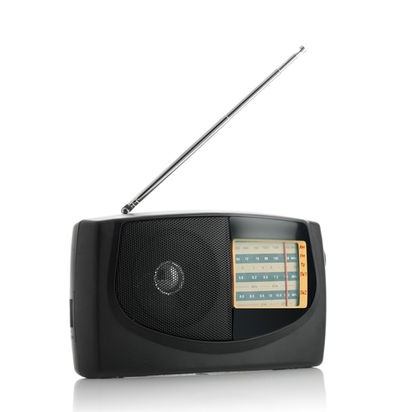Radio

Radio is the technology that allows information to be transmitted and received over radio waves. Radio makes it possible to establish wireless two-way communication between individual pairs of transmitters/receivers and it is used for one-way broadcasts to many receivers. Radio signals can carry speech, music, or digitally encoded entertainment. Radio waves occur naturally in space or can be created by people. They are a long-wave form of electromagnetic radiation, or radiation that transmits energy through the interaction of electricity and magnetism.
The history of radio
In the nineteenth century, Scottish physicist James Clerk Maxwell (1831–1879) developed a mathematical theory proving that magnetism and electricity were related. His theory linking the two forces became known as the electromagnetic theory. He predicted that light is only one type of electromagnetic radiation and that wavelengths should exist below infrared (those situated outside the visible spectrum at the red or long-wavelength end) and above ultraviolet (situated outside the visible spectrum at the violet or short-wavelength end). In the 1880s, German physicist Heinrich Hertz (1857–1894) discovered extremely long-wavelength radio waves, proving Maxwell's theory.
Italian physicist and engineer Guglielmo Marconi (1874–1937), fascinated with Hertz's discovery of radio waves, built his first crude radio transmitter and receiver in 1895. In 1901, using his "wireless" (as radio was called then), he sent the first message via signals similar to Morse code (which uses dots and dashes for letters and numbers) across the Atlantic Ocean. In the succeeding years, other scientists improved on Marconi's invention, and it eventually became possible to send voice signals by radio waves.
Radio broadcasting as we know it today began in 1920. Station KDKA in Pittsburgh, Pennsylvania, made the announcement to the few people who owned radio receivers that Warren G. Harding had been elected president of the United States. Within a few years, many homes had radio receivers and several radio stations scheduled regular programming.
Radio waves and frequencies
Although turning on a radio produces sound, radio waves themselves cannot be "heard" and have nothing to do with sound waves. While sound waves are a vibration of the air, radio waves are electromagnetic and a part of the light spectrum. Radio waves travel at a speed of 186,282 miles (299,727 kilometers) per second—the speed of light. Radio waves travel through the air, surrounding us with vibrations that can only be detected through a radio receiver.
Radio programs begin as sound waves, which microphones change into electrical signals. From the antenna atop the radio station, the electrical signals are broadcast as electromagnetic waves. The receiver picks up the waves in the air, electrically amplifies (enlarges) them, and converts them back into sound through the speaker of the radio in your home.
Although radio waves from many stations surround us all the time, the radio does not receive them all at the same time because the stations broadcast at different frequencies. A frequency is the number of times per second that radio waves vibrate. The numbers on a radio dial represent the frequencies used by radio stations in your area. For example, if the dial is set at 96, the radio signal you hear is broadcasted at 960 kilocycles, or 960,000 cycles per second.
Words to Know
Carrier wave: Radio signal with superimposed information.
Electromagnetic radiation: Radiation that transmits energy through the interaction of electricity and magnetism.
Infrared radiation: Electromagnetic radiation of a wavelength shorter than radio waves but longer than visible light that takes the form of heat.
Modulation: Process by which a characteristic of radio waves, such as amplitude or frequency, is changed to make the waves correspond to a signal or information that is being transmitted.
Ultraviolet radiation: Electromagnetic radiation of a wavelength just shorter than the violet end of the visible light spectrum.
Wavelength: The distance between two peaks in any wave.
Modulation
A radio signal alone, without information (speech, music) added to it, is called a carrier wave. Adding information to a carrier signal is a process called modulation. The simplest modulation method is to vary the strength of the signal. The result is called amplitude modulation, or AM. The method that varies the signal's frequency is known as frequency modulation, or FM. AM radio waves are about 1,000 feet (1,600 kilometers) in wavelength, while FM radio waves are only a few feet in wavelength. Broadcasts on AM radio stations can often be heard for hundreds of miles, especially at night when electromagnetic interference is minimal. Broadcasts on FM stations do not travel such a distance, but they have better sound quality and are not affected by lightning-caused static that often plagues AM broadcasts.
[ See also Electromagnetic spectrum ]
